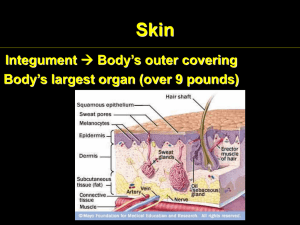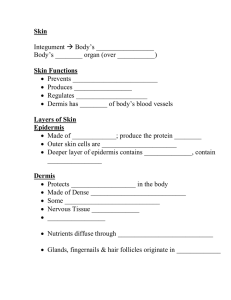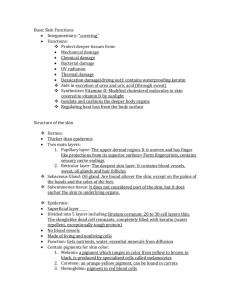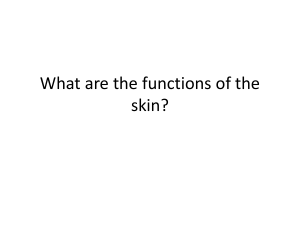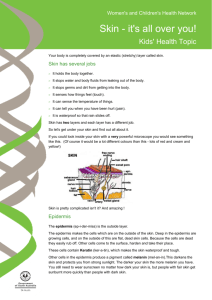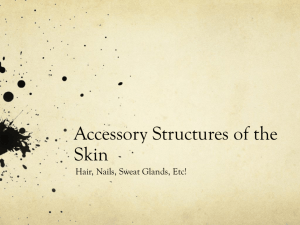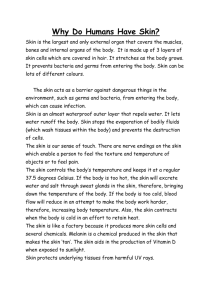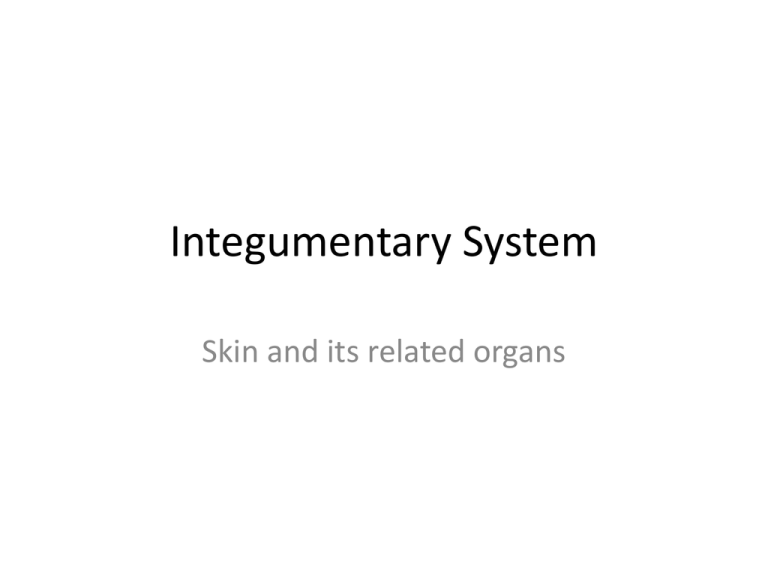
Integumentary System
Skin and its related organs
I.
•
•
•
•
•
Properties of the skin
1.
2.
3.
4.
5.
Waterproof
Stretchable
Washable
Permanent press
Autorepair
II.
•
•
•
•
•
Functions of skin
A. Limit dehydration
B. Protection
C. Insulation
D. Sensory receptor
E. Temperature
regulator
• F. Blood resevoir
• G. Excretion
B. Dermis
• 1. dense irregular
connective tissue
2. binds body together
• 3. hide
• 4. tanned hides are
called leather
• 5. Papillary
– a. Peg-like projection
– b. May contain dense
capillary beds
– c. Touch receptorsMeissner’s corpuscles
– d. Dermal ridges on hand
and feet
6. Reticular layer
•
•
•
•
•
a.
b.
c.
d.
e.
2/3’s thickness of dermis
collagen gives strength and binds water
elastin stretch recoil
lines of cleavage
flexure lines-dermal folds
III.
Components of skin
• A. Epidermis
– 1. stratified
squamous
– 2. keratinocytes
– 3. melanocytes
– 4. Langerhan’s
cells
– 5. Merkel cell
– 6. Nonvascular
7.
Homeostatic
imbalance
• a. Striae
(stretch
marks)
• b. Blister
IV.
Skin color
• A. melanin
– 1. protective
– 2. absorbs UV
• B. carotene
– 1. yellow/orange
– 2. statum corneum
• C. hemoglobin
D. Homeostatic imbalance
•
•
•
•
•
1.
2.
3.
4.
5.
erythema
blanching
jaundice
hematomas
melanoma
V. Skin appendages-epidermal derivatives
• A. Sweat Glands/sudoriferous
glands
– 1. 2.5 million
– 2. eccrine most numerous type
a.
b.
c.
d.
Release sweat
99% water
Urea
Sympathetic ANS
2. Apocrine sweat glands
•
•
•
•
•
•
a. Located in the anogenital/axillary area
b. Fatty substances and protein
c. Empties into hair follicles
d. Aromatic
e. Ebb and flow with menstrual cycle
f. Development influenced by arrival of sex
hormones
• g. Scent glands
3. Ceruminous glands
• 4. Mammary glands
B. Sebaceous Glands
• 1. all surfaces except palm
and plantar surfaces
• 2. esp. prominent face,
neck, upper chest
• 3. secrete sebum into hair
follicles
• 4. oilish dead remains of
glandular cells
• 5. functions:
– a. Moisturizes skin and hair
– b. Waterproofs
– c. Bacteriostatic
6. Imbalance terms
•
•
•
•
a.
b.
c.
d.
Whitehead
Blackhead
Acne
Seborrhea/cradle cap
C. Hair follicles
• 1. epidermal
derivative
• 2. shaft
• 3. arrector pili
• 4. bulb
• 5. functions
–
–
–
–
a.
b.
c.
d.
Sunscreen
Protection
Sensory
Insulation
VI.
Burns
• A. Problems
– 1. loss of body fluids
– 2. electrolyte disruption
– 3. renal shutdown
– 4. circulatory shock
B. Needs
1. Fluid replacement
2. Huge caloric supplements
3. Infection control after 24 hours
C. Level of Severity
• 1. first degree burn
• 2. second degree
burn-blisters
• 3. third degree burn
• 4. partial versus full
thickness burns
VII. Temperature regulation
• A. Components of feedback loop
– 1.
– 2.
– 3.
– 4.
– 5.
– 6.
receptor
afferent pathway
control center
efferent pathway
effector
response or product
B. Body temperature results from balance between
heat production and heat loss
• 1. Body at rest most of heat produced is generated by
–
–
–
–
–
a.
b.
c.
d.
e.
Liver
Heart
Brain
Endocrine organs
Inactive muscle 20% of body heat
2. Vigorous exercise skeletal muscle can produce 30-40X the heat that
the above sources produce
C. Normal body temperature 98.6
•
•
•
•
•
•
•
•
•
1. does range between 96-100
degrees
2. lowest in morning
3. high temperature late in
afternoon
4. important to keep temperature in
this range
5. for each 1 degree rise in
temperature, metabolic rate
increases 10%
6. Above homeostatic range,
nervous activity becomes depressed
and body proteins break down
7. 106 convulsions
8. 110 absolute limit for life
9. can withstand cooling much
better
D. Core and shell temperature
• 1. core highest temperature-organs within body cavities
– a. Temperature taken to measure health
– b. Oral temperature often .7 degrees cooler than rectum
• 2. shell-skin represents the heat loss surface
– a. Usually cooler than core
– b. Varies widely with need to regulate
– c. Varies 68-104
E. Heat promoting effectors
• 1. vasoconstriction of cutaneous vessels
• 2. increase in metabolic rate with increased activity of the
sympathetic nervous system
• 3. Shivering
• 4. Increased thyroid activity
F. Heat loss mechanisms
• 1. vasodilation of cutaneous vessels
• 2. enhanced sweating
G. Homeostatic imbalance
• 1. hyperthermia
a. Elevated body temperature
b. Deactivates hypothalamus which is the control
center for temperature regulation
c. Heat control suspended
d. Creates positive feedback cycle
e. Increasing temperatures increase metabolic rate
f. Increases heat production
g. Skin becomes hot and dry
2. Fever
• a. Controlled hyperthermia
• b. Results from infection
• c. WBC’ and other tissues release
pyrogens (fire starters)
• d. Hypothalamus thermostat reset
• e. Body promotes heat promoting
efforts
– Vasoconstriction and shivering
– Temperature rises
• f. Increased temperature increases
metabolic rate speeding rate of healing
• g. Inhibits bacterial growth


